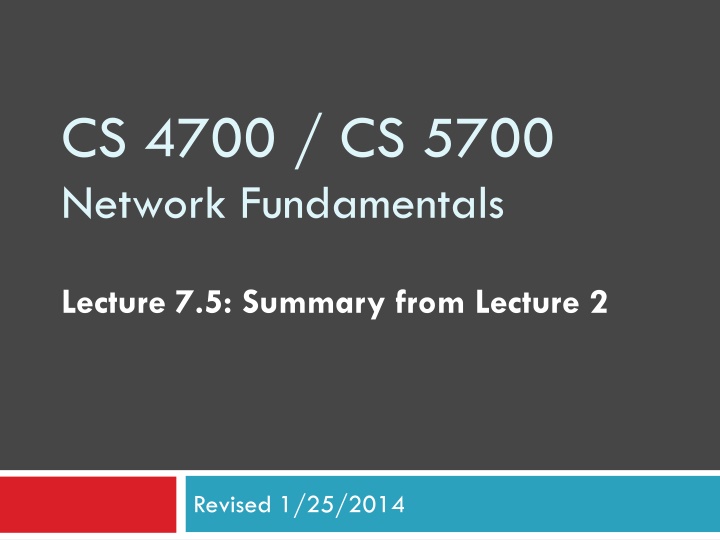
Network Fundamentals Lecture Summary and Paper Reviews
Explore key concepts from the lecture, including physical layer operations, error detection, media access control, and discussions on papers by Perlman and Shaikh addressing network challenges and monitoring large-scale networks effectively.
Download Presentation

Please find below an Image/Link to download the presentation.
The content on the website is provided AS IS for your information and personal use only. It may not be sold, licensed, or shared on other websites without obtaining consent from the author. If you encounter any issues during the download, it is possible that the publisher has removed the file from their server.
You are allowed to download the files provided on this website for personal or commercial use, subject to the condition that they are used lawfully. All files are the property of their respective owners.
The content on the website is provided AS IS for your information and personal use only. It may not be sold, licensed, or shared on other websites without obtaining consent from the author.
E N D
Presentation Transcript
CS 4700 / CS 5700 Network Fundamentals Lecture 7.5: Summary from Lecture 2 Revised 1/25/2014
Project 1 in, Project 2 out 2 Project 1 will be graded this week Project 2 Any questions?
Summary from last class 3 Physical layer Move bits around Synchronize to determine when bits start/end Link Layer Framing Error detection Media Access Control Collision Avoidance/Detection Wired/Wireless (sensing/DCF) Hubs, switches, bridges and spanning trees
Todays class 4 Paper reviews Spanning Tree OSPF in operational networks Network layer Addressing Routing Packet delivery Intradomain routing Next week: Interdomain routing
Perlman paper 5 This paper won her a SIGCOMM award in 2010 Key take-aways Not reasonable to assume topologies are loop free, and we need a way to route between LANs automatically Low memory consumption Scalable bandwidth consumption Converges quickly Tunable
Perlman paper (2) 6 Implementation details Timers everywhere How else do we know when a link is down? Also can prevent transient loops (hold down) Loop detection/avoidance This comes up often in networking Deterministic behavior Allows operators to reason about changes Very hard to do in wide area! Compare this with BGP when we get to it
Shaikh paper 7 Key take-aways Understanding the state of large-scale networks is hard Especially when they are self-managing Best way to monitor is to participate in the protocol Real time is critical, so separation of functionality is critical Offline vs online analysis Must not adversely affect the network Modeling the network allows us to identify anomalies Flaps Message storms Etc
Shaikh paper (2) 8 Networking and operators Operators are extremely cautious people Tend to lack good tools for understanding the network Routers are not perfect Router bugs, flapping due to load, improper timers Generally hard to detect if you re not looking for it Humans are definitely not perfect Bad configs, e.g.
